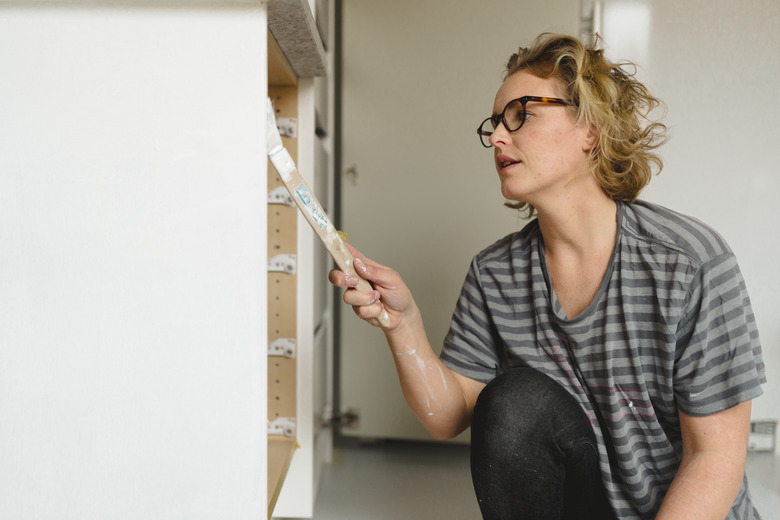How To Touch Up Cabinet Paint
Cabinets in the kitchen, bathroom, garage or other bustling living space tend to get the brunt of everyday living. Slammed, hip-checked, pushed and propped open, the cabinet facade receives a lot of abuse.
Often, dabbing a bit of touch-up paint on kitchen cabinets or sanding out divots and rolling on a square of protective coating can make the cabinet look new again. There are a few ways to properly apply paint to the cabinet surface, such as with cabinet touch-up sticks, a small brush and matching paint or sponging over the repaired area with contrasting paint. Kitchen cabinet paint repair is relatively easy and an inexpensive way to preserve the aesthetic and integrity of the structure.
Tip
Using matching paint on divots and scratches when they are first noticed will ensure that the entire cabinet facade doesn't need a whole new paint job.
Touch-Up Paint for Kitchen Cabinets
Touch-Up Paint for Kitchen Cabinets
A cabinet with a few nicks that show the underlying color or building material can be touched up quickly. If you have the can or a small container of paint from when the cabinets were originally painted, then it will be a quick task. Simply swipe a small amount of paint over the imperfection and blend gently into the surrounding painted area.
For wood cabinets with marks, divots or scratches, a cabinet touch-up stick or marker can blend the imperfection into the rest of the wood or paint. Home Crest Cabinetry recommends degreasing the cabinet surface and waiting until it is thoroughly dry before using a cabinet touch-up stick on the cabinet surface. You can also use a contrasting paint and dab it over a partial area of the outer surface of the cabinet to hide serious gouges and nicks and change the look of the kitchen decor altogether.
For larger or deeper gouges in the paint, you may want to sand the area around the flaw with a fine-grit square of sandpaper doubled over. Be gentle and blend the gouge into the rest of the cabinet facade until it is relatively smooth. Dab on the paint and gently smooth the paint with the brush into the original paint job.
Repainting an Entire Cabinet Face
Repainting an Entire Cabinet Face
If a cabinet door or surrounding structure is gouged or otherwise damaged, then it likely needs more than a few spots of touch-up. Kitchen Cabinet Refacing suggests that before you begin to roll on that slick layer of perfect paint color, the cabinet surfaces should be checked for nicks, gouges, scratches and other issues. When done properly, cabinet surface repair can save you from having to redo the paint job.
Paint can bring out every flaw and imperfection on the surface of the kitchen cabinet. The paint will roll on unevenly or possibly pool in tiny divots on the facade of the kitchen or bathroom cabinets. Move slowly over the cabinet surface and mark each divot or gouge with chalk or other nonpermanent marker. Use fine-grit sandpaper, such as 320, to go over the entire surface of the cabinet, paying close attention to the areas that you have marked. Once the surface is even and devoid of marks in the facade or leftover varnish, the cabinet is ready to receive a coat of paint.
